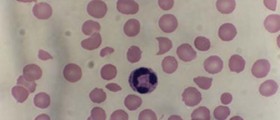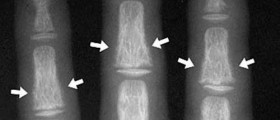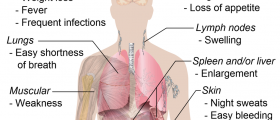What is Alkaline Phosphatase?
Alkaline phosphatase or basic phosphatase is an enzyme, more specifically, a hydrolase enzyme. Alkaline phosphatase is produced in several organs in the body, including the liver and the bones, and the placenta in unborn babies, and its concentration is highest in developing bones and bile.
The role of alkaline phosphatase is to cut out the phosphate group from some kinds of molecules. These molecules include proteins, alkaloids, and nucleotides. The chemical process by which the phosphate group is cut out, that is, removed from a molecule is known as dephosphorylation.
Alkaline phosphatase got its name because it is suited for functioning in an alkaline environment. Alkaline phosphatase is secreted during processes that are normal for the body, such as bone growth and pregnancy, but another condition that stimulates the secretion of alkaline phosphatase in the blood is injury.

The normal level of alkaline phosphatase in the organism is between 20 and 140 IU (international units, measured and determined by the biological activity of the substance) per liter. If the level of alkaline phosphatase is outside this range, meaning that it is too high or too low, that could be a sign of various health problems.
For example, too high of a concentration of alkaline phosphatase might be a sign of obstruction of the bile duct, or some bone disease or liver disorder. But it is important to note that the level of alkaline phosphatase is high in children that are growing and women that are pregnant and that this is natural and normal. On the other hand, low levels of alkaline phosphatase in the blood is indicating that there is some kind of deformation affecting the bones.
Causes of Low Level of Alkaline Phosphatase
A low level of alkaline phosphatase in the blood can be caused by several medical conditions. Here, we will mention only the most common disorders that cause this condition.
Hypophosphatasia is a rare metabolic bone disease, but lethal in occurrence but fatal to the sufferer. It is characterized by a very low amount of mineralization of the bones and early loss of teeth. It is caused by a gene mutation.
- In this study, the prevalence of low AP activity and elevated pyridoxal-5-phosphate (PLP) levels was analyzed in 6.918.126 measurements from 2011 to 2016 at a single laboratory in northern Germany. Only laboratory values of subjects older than 18 years of age were included. Only the first measurement was included, all repeated values were excluded.
- In total, 8.46% of the measurements of a total of 6.918.126 values showed a value?30 U/L. 0.59% of the subjects with an ALP activity below 30 U/L had an additional PLP measurement.
- Here, 6.09% showed elevated pyridoxal-5-phosphate (PLP) levels. This suggest that 0.52% (1:194) of subjects show laboratory signs of HPP.
Aplastic anemia is caused by insufficient production of new blood cells. Its symptoms are constant fatigue, poor immunity, and uncontrolled bleeding. Chronic myelogenous leukemia is a slow version of leukemia, and it usually affects elderly persons.
Treatment
Unfortunately, no treatment can restore alkaline phosphatase level from low to normal, but the condition can be controlled and the symptoms can be somewhat reduced. Treatment is based on the administration of NSAIDs, alkaline phosphatase replacement compounds, and surgery. The type of treatment depends on the exact cause of the disorder.
- medlineplus.gov/lab-tests/alkaline-phosphatase
- www.webmd.com/digestive-disorders/alkaline_phosphatase_test
- Photo courtesy of Jawahar Swaminathan and MSD staff at the European Bioinformatics Institute by Wikimedia Commons: commons.wikimedia.org/wiki/File:PDB_2ib8_EBI.png
















Your thoughts on this
Loading...